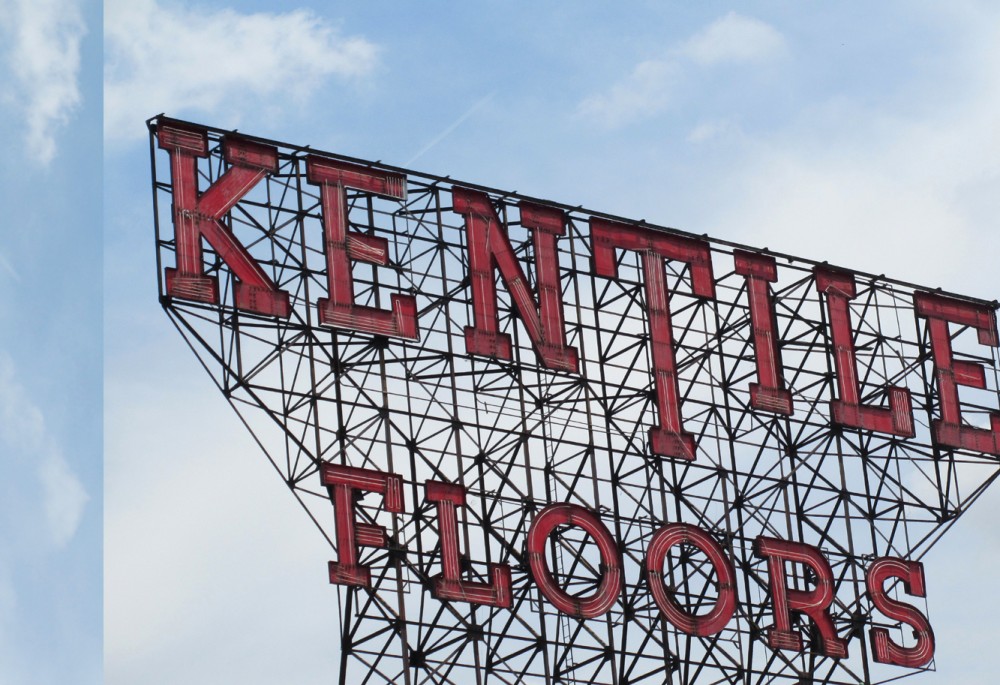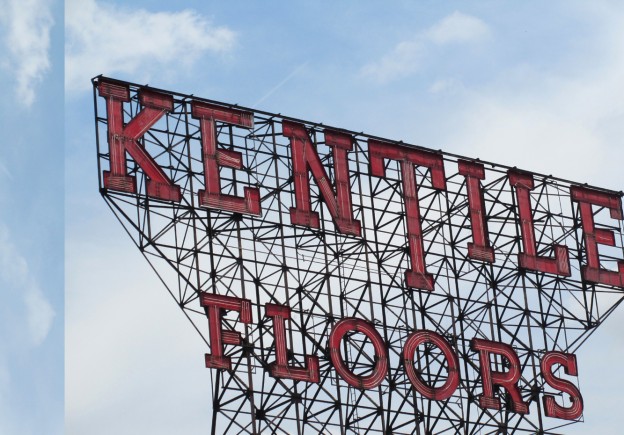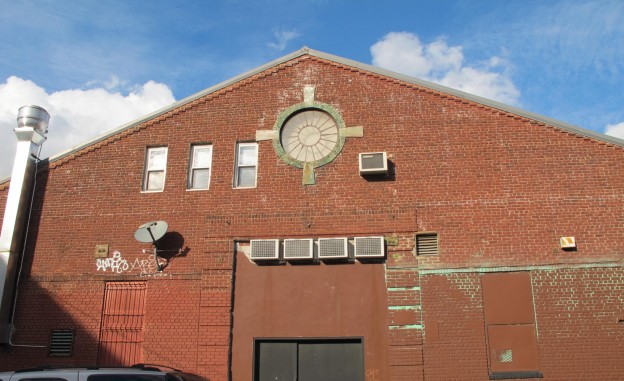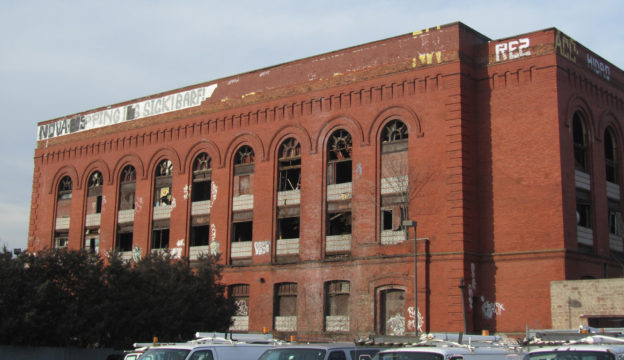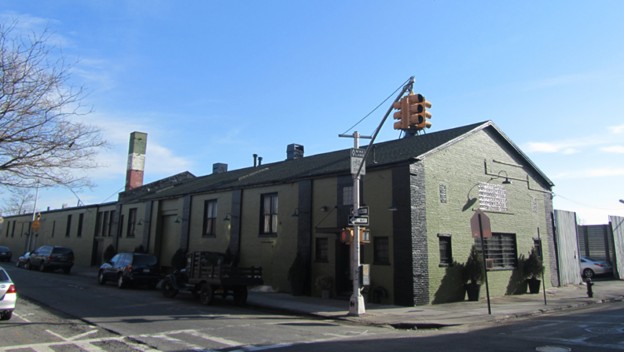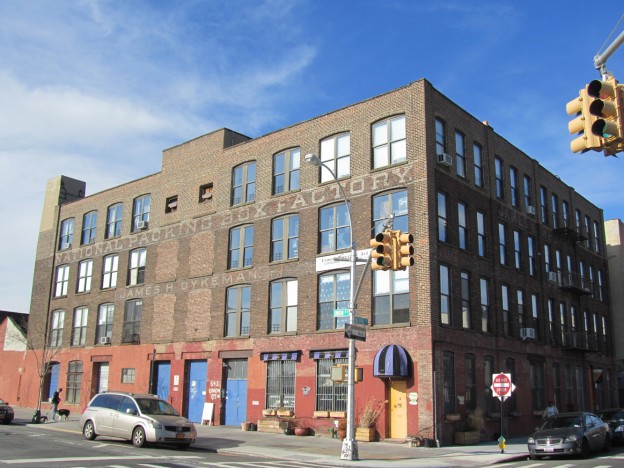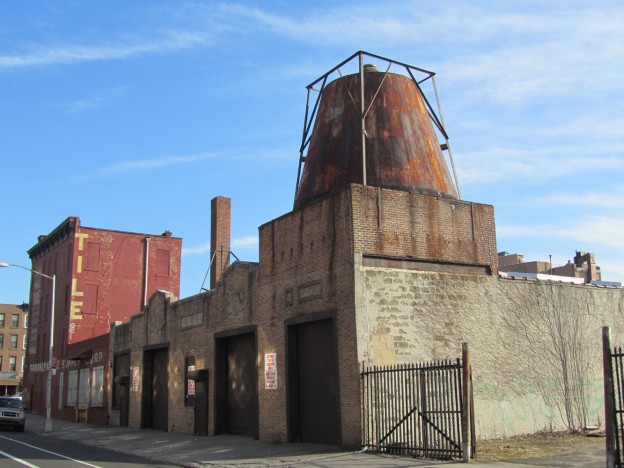9th Street and 2nd Avenue;
1949|
The Kentile Floor Company, founded by Arthur Kennedy in 1898, opened its third location here in 1949. Kentile was a pioneer in the “do-it-yourself ” industry of home improvement. Advertisements featured housewives putting in the floor tiles themselves, implying the simplicity of installation. While Kentile has not been present here since the 1990s, the site is still used for manufacturing.
The sign was dismantled in 2014. The Gowanus Alliance is trying to erect the sign in another location.
2nd Avenue;
1915–38|
Coal was one of the major freights shipped on the canal in the 19th and 20th centuries. Initially, coal was used for domestic heating and cooking, and it later was burned to generate electricity. Coal pockets were used to move and store the coal from barges on the canal to wagons and, later, trucks for delivery. The eight pockets closest to the water were built between 1915 and 1924, and by 1938 there were 10 more. These 40 and 50-foot tall structures are no longer used today but remain as relics of the canal’s crucial transportation role.
400–04 3rd Avenue
ca. 1910
This early-20th-century industrial building sits across the street from the Eagle sign. Note the ocular window with keystones.
6th Street and 4th Avenue;
1951|
This sign hovers above what was once the Eagle Clothing Factory, which moved to Gowanus and built a brand-new factory here in 1951. The factory had many modern amenities such as adequate space and lighting, air-conditioning and a recreational roof garden. The company owned this property until 1989, and the sign remains as it has been for 60 years in this neighborhood.
The sign was removed in 2013.
232 3rd Street;
ca. 1886|
Within a year of its opening, this factory was producing 1,800 tin boxes per week and within a decade grew to be a company with more than 150 employees. Oil, pumped from iron tank boats on the Gowanus Canal, powered the factory. The company sold this location to the American Can Company in 1901. Today the building retains a functional use as spaces for designers, artists and manufacturers. Visually, it is a testament to Gowanus’ industrial past and its ability to adapt to serve current production needs. Sonic Youth recorded its first three albums at this complex.
370 3rd Avenue;
William Field & Son;
1872–73|
This New York City individual landmark is the sole survivor of a factory complex that originally was five acres large and spanned from 3rd to 6th Streets along the Gowanus Canal. It was constructed as the showpiece, and served as the office, of the New York & Long Island Coignet Stone Company, one of the first companies in the United States to industrialize the production of concrete. Not surprisingly, it is the oldest known concrete structure in New York City. The building features a poured-in-place foundation and original pre-cast concrete stones and blocks on the upper stories. It is also likely that the floors are reinforced concrete. The company was named for François Coignet, who patented Beton Coignet Concrete in France in the 1850s, and produced the material at this location. Concrete was cast in molds and was much more affordable than chiseling natural stone. A large-scale modern supermarket project surrounding the building was approved in 2012.
322 3rd Avenue;
1902|
This massive eight-story Romanesque Revival style building served as the powerhouse for the Brooklyn Rapid Transit Corporation, or BRT. The BRT owned every steam railroad, elevated line and streetcar in Brooklyn at the turn of the 20th century, and this enormous building burned coal to generate electricity for all of the trains. Coal was fed from the canal bank via a coal elevator to a cement tunnel connecting the coal pit and the larger boiler building. The currently vacant building, the only remnant of what originally was an extensive complex, is under threat by neglect and abandonment.
aka The Green Building;
Ca. 1948|
This site has hosted a variety of industry since the Gowanus first began to operate shortly after the Civil War and is reflective of how long industry has characterized the area. It was previously home to Thomas Paulson & Son, a brass foundry. In 2002, plans were made for the demolition of the building and its subsequent replacement with a luxury residential tower. After much community outcry and two years of discussion with the Board of Standards and Appeals, the site was not granted a residential rezoning and the building was saved. The building is being adaptively reused as an event space and serves as a symbol of the strength of the Gowanus community’s determination to preserve its industrial heritage
543 Union Street;
Robert Dixon;
ca. 1910|
James A. Dyckeman commissioned architect Robert Dixon to construct this industrial building for his box factory. Eventually the business increased and became a five building complex. A portion of this building burned in 1932, and by 1936, Dyckeman’s company was bankrupt. Other industries that have operated here include brass and cabinet manufacturing. The building is still in use today and is currently home to Proteus Gowanus, an interdisciplinary gallery and reading room. Housed within Proteus is Gowanus Hall, a museum dedicated to the history of the canal itself.
638–44 Degraw Street;
1923|
This auto garage on the south side of Degraw Street is a survivor of the early presence of the automobile in New York City. Eureka shops were an early chain of automotive repair establishments. The building is constructed of tan brick laid in Flemish bond with decorative panels featuring automobile tires with wings, evidencing the building’s original use. The façade is largely original and intact.
